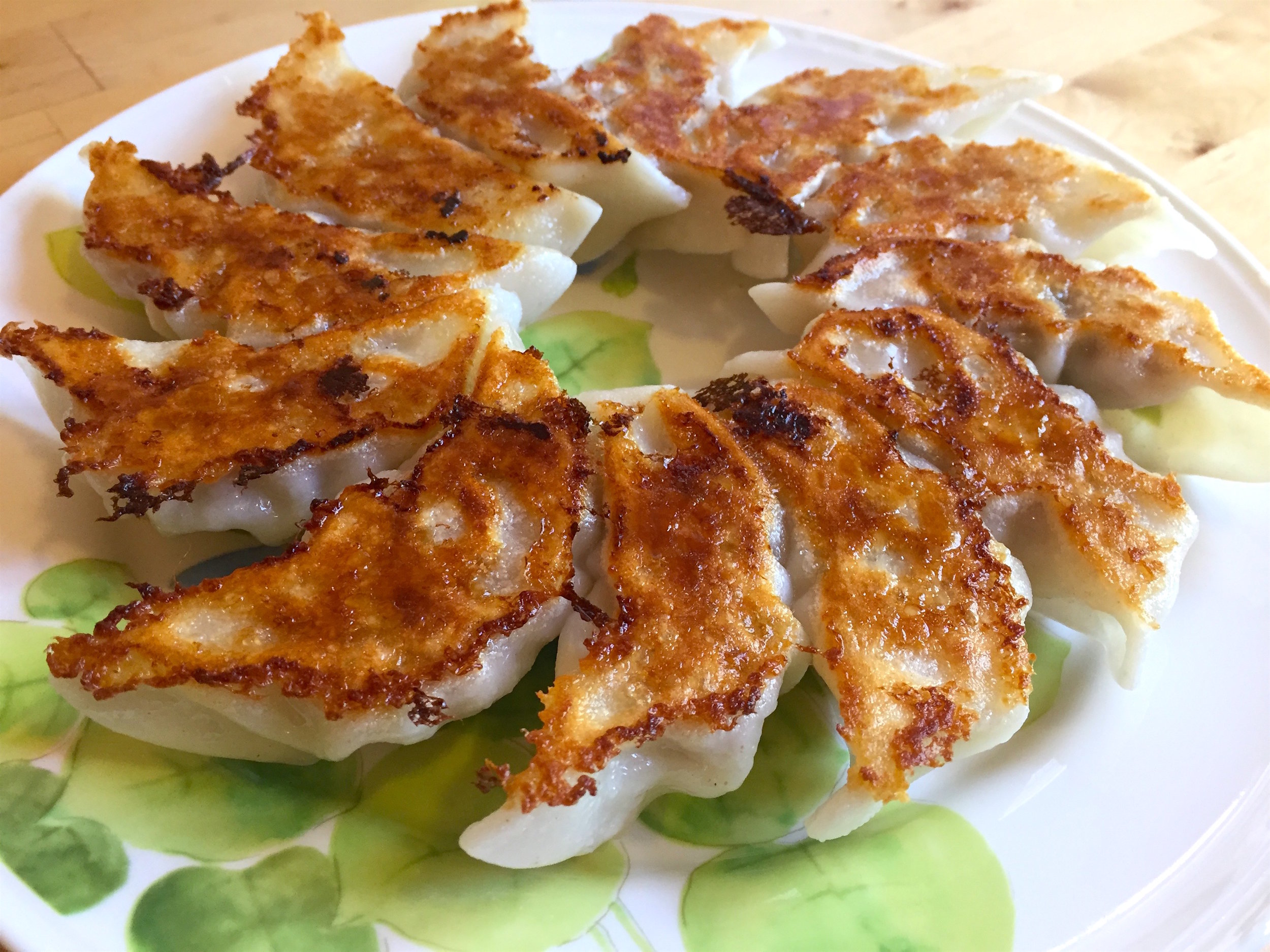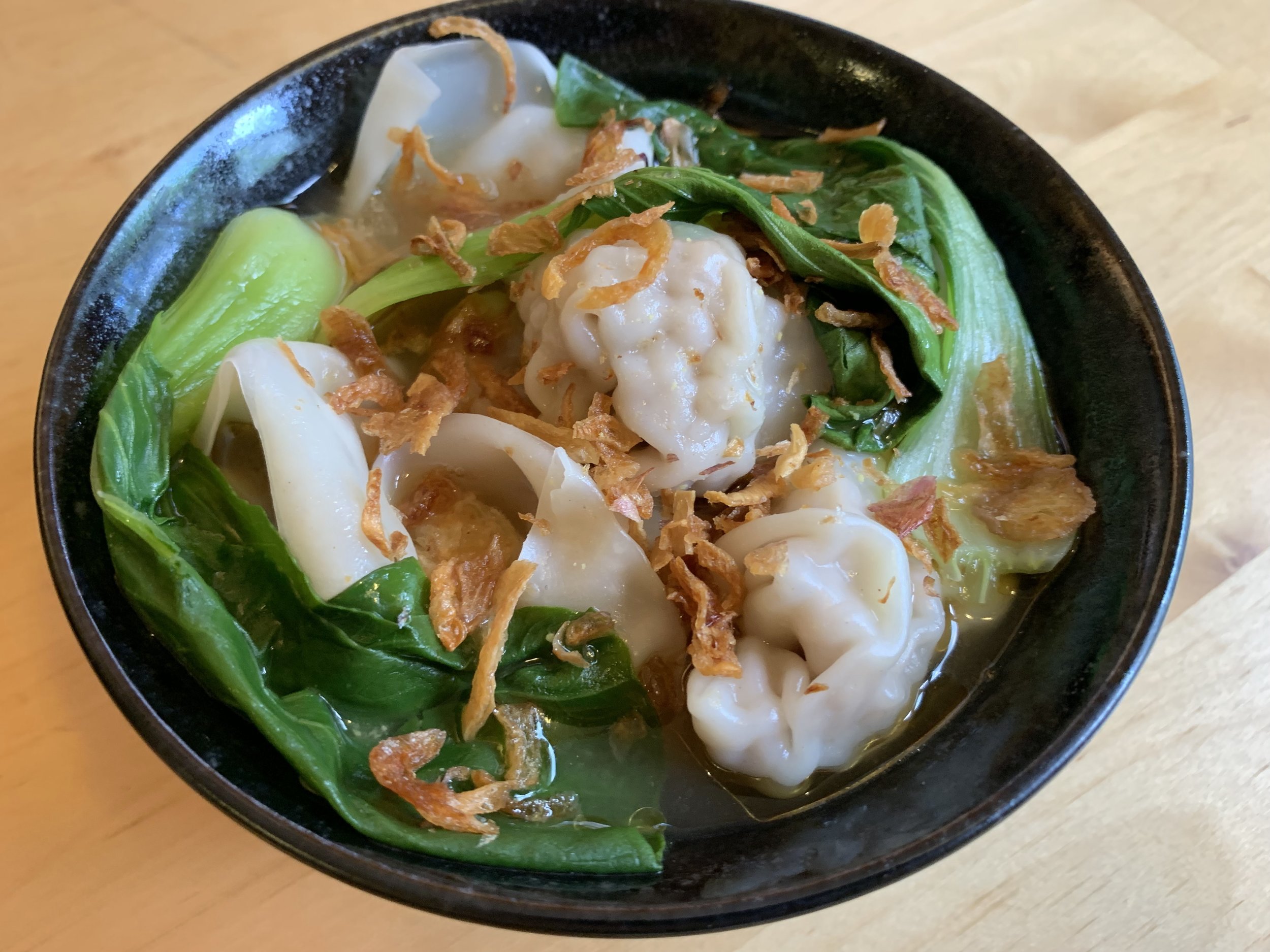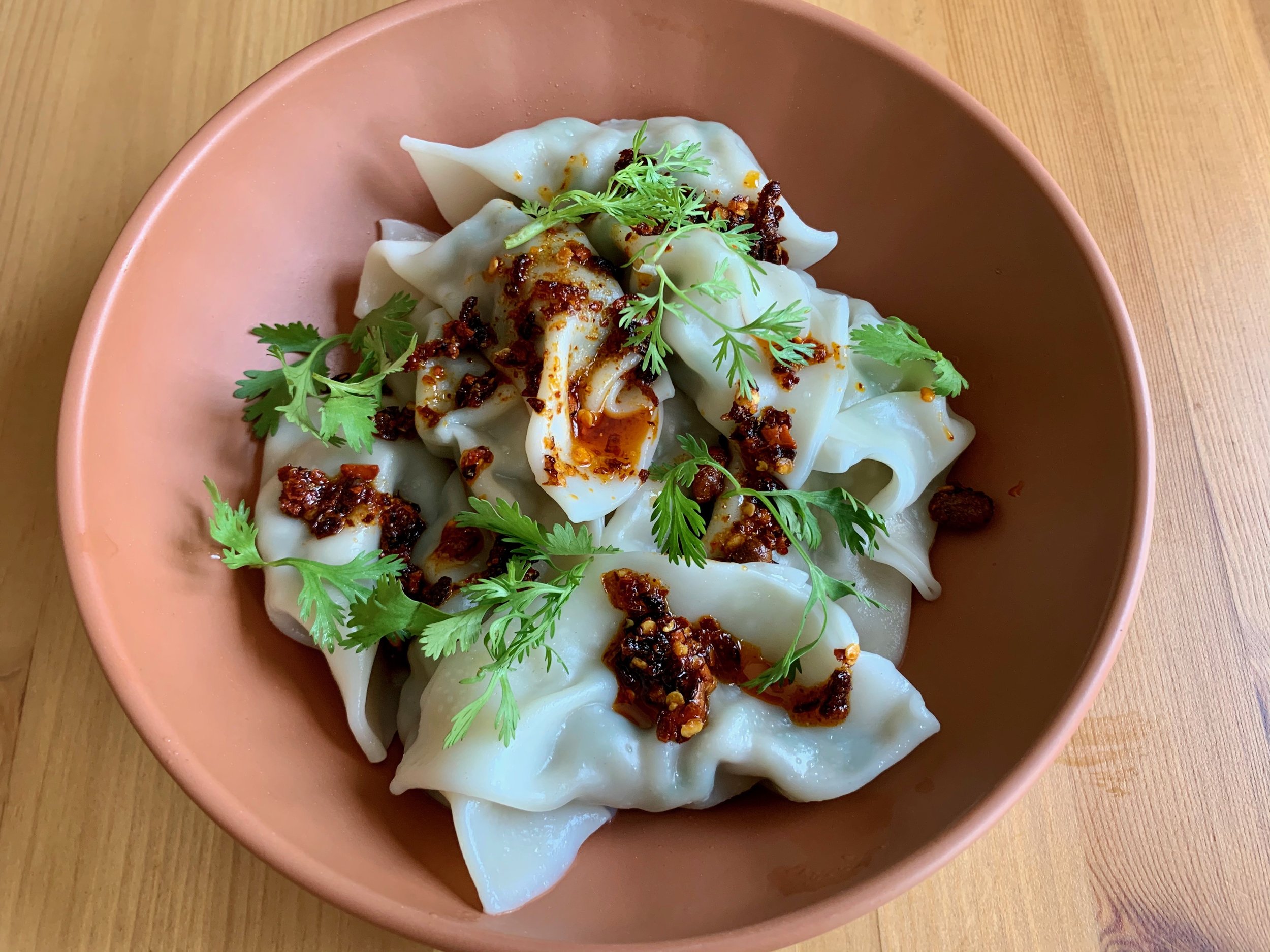Pork and Chive Potstickers

韭菜煎餃
(Jiu Tsai Jian Jiao)
It is said that the first potstickers were created a cook who forgot about a pot of dumplings boiling on the fire, until all the water evaporated and they stuck to the bottom of the wok. The nervous cook then served the ruined dumplings to his master, who praised the cook for his new creation. While most dumplings can be prepared as potstickers, it’s hard to beat purpose-made potstickers. Because they can be constructed without the rigors of boiling in mind, potstickers can have thin, delicate skins which crisp better in the pan. We can also create a flat, rectangular shape which will give us more surface area for even more crunch.
This recipe uses the same pork and chive filling as our dumpling recipe, but uses thinner wrappers to create tender and crispy potstickers. These potstickers (煎餃) are often part of a hearty Taiwanese breakfast, or a late snack at a night market.[1]
Ingredients
1½ lb ground pork
1 pkg thin potsticker wrappers
12 oz garlic chives, chopped
3 scallions, chopped
1 tbsp cornstarch
1 tbsp soy sauce
2 tsp sesame oil
1 tbsp Shaoxing rice wine (optional)
2 tsp white pepper
½ tsp salt
Vegetable oil
Garlic chives have a distinct fragrance somewhere between garlic and onion, and pair well with pork.[2] Wash the chives thoroughly, and then finely chop them. We are looking for pieces about ¼ of an inch long. Finely chop the scallions as well, and add the vegetables to a large mixing bowl together with the pork, salt, pepper, soy sauce, sesame oil, rice wine, and cornstarch. Mix thoroughly with a large spoon or clean hands, until the filling is well combined.
At this point you will want to check for seasoning—the best way to do this is to take a small scoop of the filling and microwave it for 30 seconds or so, until it’s fully cooked. Adjust the seasoning to your taste, then prepare to wrap. You can prepare the filling up to two days in advance of wrapping if you wish. Cover tightly and store in the refrigerator.
For these potstickers, it is important to use thin wrappers. You can use either normal flour wrappers or egg dough wrappers, but look for the thin wrappers made specifically for potstickers. If you can’t find these, then use square wonton wrappers, which are about the right thickness for this recipe.
On a clean table or counter, prepare a workspace for wrapping the potstickers. The potsticker wrappers, if frozen, should be fully thawed. It is important to stop the wrappers from drying out, so depending on how fast you can work, and how humid the air is, it is often a good idea to keep the wrappers covered before wrapping, either with plastic wrap or a clean tea towel. A towel is also useful for drying your fingers. Fetch a small bowl of cold water for sealing the potstickers, and prepare a landing zone for the completed potstickers. If you plan on cooking them all immediately, go ahead and pile the potstickers up on a plate, but if you are planning on freezing the potstickers, prepare a plate, cutting board, or sheet pan covered in plastic wrap or parchment paper. The potstickers should be placed in a single layer with a small amount of distance between them so they freeze individually.
The shape of these potstickers is a simple flattened roll. Place a wrapper in the palm of your hand and scoop about 1 tablespoon of filling into the center. Shape the filling into a long rectangle. Then fold one side of the wrapper over the filling. With your other hand, dip a finger in the cold water and moisten the top of this fold. Then, fold the other side of the wrapper over and press to seal the sides together. If necessary, flatten the potsticker so it is no more than ½ an inch thick. The two ends of the roll will remain open—this is fine because we will not be boiling these potstickers.
When you are done wrapping, if you intend on freezing the potstickers, put your parchment or plastic wrap lined surface into the freezer. After 6 hours or so, the potstickers should be rock solid. Transfer into a zipper storage bag for convenient storage in the freezer.
To Cook
To prepare the potstickers, begin by heating about a tablespoon of oil in a nonstick skillet over medium heat. Add the potstickers in a single layer, frying for about a minute. Once the potstickers hit the skillet, do not move them until the very end. This first fry will help build a crust on the bottom, leading to a crunchier final product after the second fry.
After a minute, add a small amount of water to the skillet. This sort of potsticker doesn’t require as much water as dumplings being cooked as potstickers, so use 2 tbsp of water if the potstickers are fresh, and ¼ cup if they are frozen. Cover the pan immediately. The water will turn to steam, cooking the potstickers. Continue to cook fully covered for 3 minutes before cracking the lid, continuing to cook partially covered until the water is mostly evaporated and the dumplings are cooked through. If you find that the water is disappearing before the dumplings are fully cooked, add another tablespoon of water.
When the water is nearly gone, forming a slurry in the pan with the oil and the flour from the dumpling wrappers, remove the lid and begin occasionally swirling the pan, moving the slurry through and around the potstickers. This action results in more even browning of the potstickers, and reduces spitting in the pan.
Gradually the water will evaporate entirely from the pan. Continue frying the potstickers over medium heat for another 2 minutes, until the bottoms of the potstickers are browned and crisp. Then flip the potstickers and fry on the other side for 2 minutes before removing from the pan.
In restaurants and street stalls, these potstickers are often lined up in an orderly row and cooked and flipped together, resulting in a stack of barely connected potstickers. You can do this at home relatively easily, as long as you have a sufficiently large spatula.
Serve the potstickers immediately, with the dipping sauce of your choice. Generally soy sauce based, dipping sauces may also include sesame oil, rice vinegar, chili oil, satay sauce, ginger, and/or garlic. My personal preference when it comes to a dipping sauce for these potstickers is 3 parts light soy sauce to 1 part sesame oil.
Substitutions
Ground chicken works well in this recipe in place of ground pork. However, because chicken is very lean, if you use chicken in this recipe you should also add a beaten egg to the mix to help with moisture and binding. Lamb and beef can also be used as potsticker fillings.
Because of how delicate the thinner potsticker skins are, the filling for these potstickers must be relatively low moisture. This excludes vegetables that we otherwise may include in a dumpling filling, such as cabbage. If you don’t like the flavor of garlic chives, remove them from the recipe and increase the number of scallions.
[1] Taiwanese night markets (夜市) are known for their variety of snack foods, called xiaochi (小吃).
[2] Garlic chives (Allium tuberosum) are sometimes referred to as Chinese chives or Chinese leek. Thus, “pork and leek dumplings” often actually contain garlic chives. To add to the confusion, however, some dumplings are actually made with leeks!
Recipe
Prep Time: 1 hr Cook Time: 10 min Total Time: 1 hr 10 min
Difficulty: 3/5
Heat Sources: 1 burner
Equipment: nonstick pan
Servings: 60 potstickers
Ingredients
1½ lb ground pork
1 pkg thin potsticker wrappers
12 oz garlic chives, chopped
3 scallions, chopped
1 tbsp cornstarch
1 tbsp soy sauce
2 tsp sesame oil
1 tbsp Shaoxing rice wine (optional)
2 tsp white pepper
½ tsp salt
Vegetable oil
Instructions
1. Finely chop the garlic chives and the scallions. In a large bowl, combine the ground pork, salt, pepper, soy sauce, sesame oil, rice wine, cornstarch, chopped scallions, and chopped chives. Mix the filling until well-combined.
2. To begin assembly, prepare a small bowl of water, and unwrap the dumpling wrappers, keeping them under plastic wrap or a clean tea towel.
3. To wrap, begin with a single wrapper in your hand. Spoon approximately 1 tablespoon of filling in the center of the wrapper, and moisten the edge of the wrapper with water using the tip of your finger. Seal the wrapper, forming a crescent shape.
4. Once all the dumplings are wrapped, cook immediately, or freeze.
To Cook
1. Heat 1 tablespoon of vegetable oil in a non-stick pan on medium heat, and add the potstickers in a single layer. Add a small amount of water to the pan, 2 tbsp if fresh and ¼ cup if frozen, and cover immediately.
2. Cook covered for 3 minutes, letting the dumplings steam. Then crack the lid and continue cooking, partially covered, until the water has nearly all evaporated. If the water runs out before the potsticker skins are fully cooked, add 1 tbsp more water.
3. When the remaining water, oil, and flour from the dumplings begin to form a thick liquid, remove the lid and swirl the liquid around the potstickers. Let the potstickers fry until crisp on the bottom—about 2 minutes.
4. Flip the potstickers and fry on the second side for 2 minutes or until crisp. Serve immediately.















